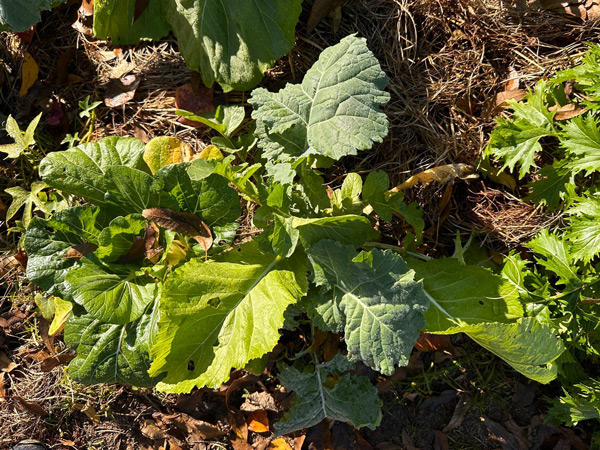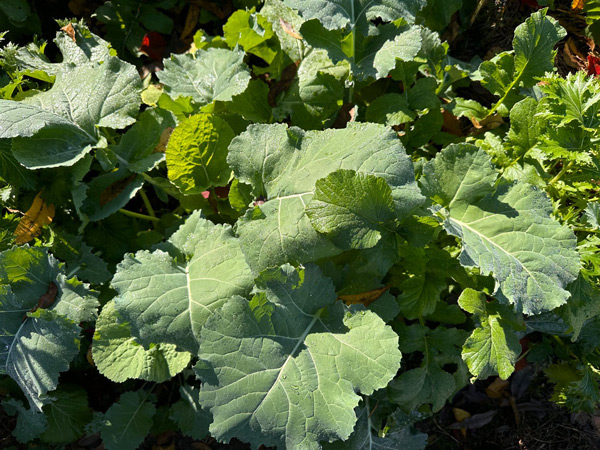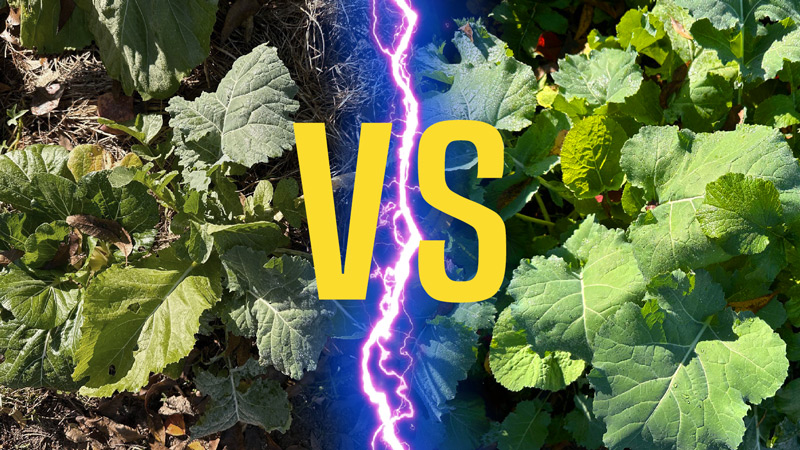Adding mimosa leaves as a fertilizer to a bed didn’t increase plant growth. Instead, it seems to have stunted it.
A couple months ago we set up a test where we added mimosa (Albizia julibrissin) leaves to one bed, with a control bed next to it. Then we planted a variety of brassicas, including mustard, pak choi and cauliflower. Interestingly, the bed with the mimosa leaves has done worse than the one without.
We got the original idea for using mimosa leaves as fertilizer from a book titled Restoring the Soil by author Roland Bunch. In that book, Bunch describes using fresh Gliricidia sepium leaves as a fertilizer by burying them next to growing crops.
We decided to do the same thing with mimosa.

Here’s what we found:
While watching that video, James asked in the live comments section:
![]()
Albizia julibrissin might have some use as a nitrogen-fixer due to the species below-ground nodulation; however, using the high-protein leaves to fertilize a garden bed was not effective. We have used alfalfa as fertilizer before and planted right away, which gave us good results, so the problem isn’t because we were “burying leaves” and soaking up the nitrogen in the soil. The nitrogen in these leaves would preclude that anyways. Burying high-carbon materials can be a problem, not buying “green” composting materials.
There is another issue going on here. My guess is that mimosa is allelopathic and suppressed the growth.
Allelopathy in Mimosa
There is a noticeable difference when the beds are compared side-by-side. It seems there is an allelopathic effect from the leaves which dwarfs brassica growth and induces earlier bolting.
A reader shared a study claiming A. julibrissin is allelopathic to the invasive “Tree of Heaven:”
“The current study evaluated the allelopathic potential of the Persian silk tree (Albizia julibrissin) leaf residues on seed germination and biomass attributes of the Tree of heaven (Ailanthus altissima) seedlings. An experiment was conducted based on a completely randomized design by eight replications. Experimental treatments consisted of different levels of leaf residues at concentrations of 0%, 2.5%, 5%,and 7.5%.Germination index was used in order to investigate the effect of allelochemicals on seeds germination. In addition, the effect of allelopathic materials on seedling biomass was measured by calculating the parameters of collar diameter, fresh and dry weight of seedlings, root dry weight, number of leaves, seedling weight vigor index and percentages of seedling water content index. The results revealed that seed germination index, seedling dry weight, seedling fresh and dry root weight and seedling weight vigor index significantly decreased at different concentrations of leaf residues compared to control, but the increase in concentration had no significant effect on these attributes. But higher concentrations of leaf residues had stronger inhibitory effects on seedling collar diameter, fresh seedling weight and the number of leaves per seedling. The present study clearly proved the allelopathic effects of the Persian silk tree (Albizia julibrissin) leaf residues on biomass attributes of the Tree of heaven (Ailanthus altissima) seedlings. In addition, the Persian silk tree (Albizia julibrissin) leaf residues can be used to control the irregular growth of Tree of heaven seed as an invasive species, as well as weed management in agroforestry systems which require further studies.”
Note that it reduces biomass, and that it was the “leaf residue” which did so.
I’ve used mimosa as a chop-and-drop tree for a decade or more, yet it appears this might not be a good idea. This is why we do backyard science experiments, instead of just assuming that a method or a species will work.
WITH MIMOSA:

WITHOUT MIMOSA:

Remarkable!
Looks like I’ll just have to plant more comfrey.


9 comments
Planting mimosa as nitrogen fixing through the roots may also be a mistake if it is going to be dropping the leaves in your garden. Probably much better options out there.
I am using Goldenball Leadtree (Leucaena retusa) which is a native tree and very similar to Mimosa. I would like to try one of the thornless varieties of Mesquite but they are too expensive and hard to find.
This looks like a great experiment, David. Do you know of a standard method for checking the allelopathic properties of a plant on a smaller plant, perhaps similar to checking for residual pesticides in compost?
That’s good to know about mimosa. I’ve been looking for one I could strip some seeds off of, because I’ve always liked the trees– they smell nice and add softness to the landscape. Nostalgic. But I’m thinking twice about that plan. Perhaps something else would fill that niche better.
In other news, I got a disappointing email from Southern Exposure Seed Company, from whom I have purchased seeds for years. Relevant excerpt:
“Are you a gardener or farmer, seed grower, seed company or seed retailer, food wholesaler/distributor, grocer, value-added food business, chef or restaurateur? Or know someone who is? Take the survey now and share with your network!
If you participate, you can opt into a raffle for one of 50 $100 gift certificates.
See Ujamaa’s message below:
Make your voice heard and help support the Ujamaa Cooperative Farming Alliance to put culture back into agriculture.
The Ujamaa Cooperative Farming Alliance (Ujamaa) is a BIPOC (Black, Indigenous, and People of Color)-led collective seeking to increase grower and crop varietal diversity in the United States. In partnership with the University of Vermont, we are conducting a research study to examine how food and agriculture can better enhance access to culturally meaningful seeds and food. This information will support farmers and other participants in the seed value chain to expand regionally adapted, sustainably grown and less commercially available varieties of seed (and the crops that come from these seeds).”
I’m bummed to see they’ve jumped on the cultural crazy-train.
Any chance that you could do a post on good places to get seeds?
Yeah, some important seed resources are getting co-opted and will lose sight of their original purpose. Your best bet is to save your own seeds and work with other people in the area who do as well. I know Glenn Drowns at Sand Hill Preservation Center has pretty much cut ties with the Seed Savers Exchange for the same reason. Hungry people don’t care whether their food is “culturally meaningful” and the best way to help is to grow good food and help others grow good food. (As an aside, I’m allergic to most of the foods that would be considered “culturally meaningful” in part of my heritage.)
I’d be tempted to take their survey…but they wouldn’t like the answers.
Yeah, That is becoming more and more obvious with each passing day. I already save the seeds from my pumpkins, radishes, tomatoes… clearly it’s time to buckle down and start saving *all* of them.
Southern Exposure is literally run by a commune, so that’s their bent. Generally, they don’t say much about it.
Oi. That’s a bummer.
If you have wisteria growing wild, that might be a good one to try next.
Thanks for the follow up on this.
Comments are closed.